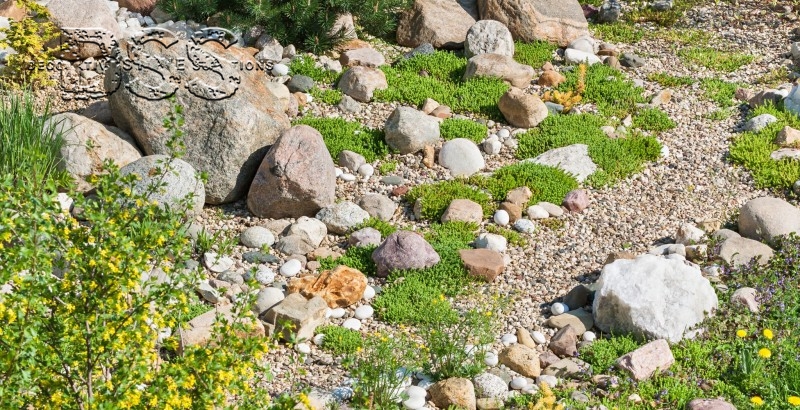Creating beautiful outdoor spaces is an art that requires a thorough consideration of a wide range of materials. Out of the endless choices, landscaping rocks is the best option for updating your outside space and incorporating a little bit of nature.
Consider yourself in the right place if you want to include these natural wonders in your garden design and need the recommendation to help you choose wisely.
This blog discusses several rock kinds and their uses to help you choose one that complements your garden and overall vision.
After all, the choice to landscaping rocks is subjective. Let's get started.
1. River Rocks
When considering rocks for landscaping, river rocks are sure to be on the list. These versatile rocks found their origin near the river beds and are smoothened from edges by the natural process and are almost symmetrical.
The availability of these stones in various shapes, sizes, and colors allows them to be the first choice in creative landscaping.
Application - River rocks find their application in the places that need filling. Creating mosaics, stepping stones, rock gardens, unique planters, and birdbaths, or as part of a larger outdoor sculpture or installation, are some of the creative and decorative ways to add warmth and beauty to any space.
2. Lava Rocks
Next on the list of outdoor rocks for landscaping comes the lava rocks, which are produced when molten rock is solidified after being ejected from a volcano.
Although expensive, the results of volcanic activity give your yard a distinctive aspect that makes it stand out from the rest. Many duplicates of these rocks made of synthetic materials are available in the market and don't cost much in the pocket.
Application - Because lava rocks are excellent temperature regulators, they are frequently used to line walkways and construct rock gardens.
They make attractive accents around fire pits, pools, and water features because of their distinctive appearance, which produces an arresting visual impression.
3. Flag Stones
One of the best landscaping rocks is flagstones, flat sedimentary rocks of different varieties (sandstone, slate, etc.) sold by weight or square foot coverage.
Landscaping by flagstones requires a single layer to sink into the even ground and get full coverage. They can be laid in a variety of patterns due to their durability, non-slip, and resistance to weathering nature.
Flagstones are an obvious choice. If you want to build a formal walkway for your outdoor space, consider the flagstones the obvious choice.
Application - These landscaping rocks are perfect for creating elaborate designs such as steps, mosaics, water features, fountains, benches, patios, walks, and decks.
Also, its flatness and durability imply it is used to create a border around a flowerbed or garden.
4. Mexican Beach Pebbles
Not only these landscaping rocks are unique and versatile but offer low maintenance. The existence of these rocks is rooted in Mexico as these expensive pebbles are made of multi-toned volcanic rock basalt.
The tumbling technique, which takes many weeks to complete and calls for specific tools and materials, is used to polish these rounded, smooth, dark-colored pebbles.
Application - These pebbles can be used to make a beautiful border or pathway, unique mosaics, fire pits, and many other things. To further improve the beauty and make them seem wonderful, they can also be utilized in pots with cacti and other varieties of xeriscape.
5. Pea Gravel
A pleasing and durable outdoor space can be created by combining different-sized pea gravels. These landscaping rocks, although larger than decomposed granite, goes by their name and are the size of a pea.
The inexpensiveness and the availability of these rocks in various hues and sizes make them an attractive and versatile landscaping material on a budget.
Application - There is no end to the inventive uses that pea gravels can be put to. These small but rounded aggregates are often found in parks and public gardens, providing a secure base layer for kids and pets.
Moreover, it can also be used to fill pathways and driveways, create walkways, and adorn garden beds.
6. Cobble Stones
Many traditionalists and fans of ancient art favor these landscaping pebbles because of their traditional and vintage appeal. Basalt, limestone, or granite are quarried to make cobblestones or Belgian blocks.
They are characterized by their rough, erratic shape and texture, sold by weight, and fall on the more expensive side.
Application - Cobblestones are frequently used to pave driveway aprons, patios, and walkways. To improve the aesthetic appeal of your outside space, these can also be utilized to line flowerbeds and make outdoor sculptures.
7. Boulders
The large and rounded landscaping rocks that are difficult to move unaided come in the category of boulders. These are typically thought of as the massive landscaping material which shows up from a distance.
These rocks can also have flat sides and are not required to have solely spherical sides. For a more natural appearance, they shouldn't only be planted; rather, they should be buried in the ground.
Application - These enormous landscaping stones can be stacked to create a distinctive and eye-catching feature in a garden or yard, giving the area a beguiling appearance. They have a function that goes beyond just being an adornment.
Wrapping Words
Decorating your outdoor space with landscaping rocks fabricates the opportunities to get creative and create an environment that is sure to be relished by the generations to come.
Your vision should, however, be reflected in the landscaping rock you choose for your garden.
To receive a comprehensive and timely response to your request, get in touch with our staff at Decorative Stone Solutions.


